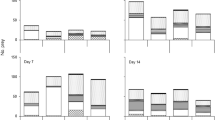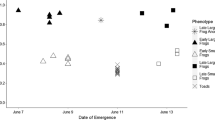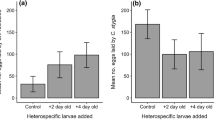Abstract
Phenological shifts can alter the relative arrival time of competing species in natural communities, but predicting the consequences for species interactions and community dynamics is a major challenge. Here we show that differences in relative arrival time can lead to predictable priority effects that alter the outcome of competitive interactions. By experimentally manipulating the relative arrival time of two competing tadpole species across a resource gradient, we found that delaying relative arrival of a species reduced the interaction asymmetry between species and could even reverse competitive dominance. However, the strength of these priority effects was contingent on the abundance of the shared resource. Priority effects were generally weak when resources were limited, but increased at higher resource levels. Importantly, this context dependency could be explained by a shift in per capita interaction strength driven by a shift in relative body sizes of competitors. These results shed new light into the mechanisms that drive variation in priority effects and help predict consequences of phenological shifts across different environments.



Similar content being viewed by others
References
Alford RA, Wilbur HM (1985) Priority effects in experimental pond communities: competition between Bufo and Rana. Ecology 66:1097–1105
Chase JM (2003) Community assembly: when should history matter? Oecologia 136:489–498
Chase JM (2010) Stochastic community assembly causes higher biodiversity in more productive environments. Science 328:1388–1391
Chesson P (2000) Mechanisms of maintenance of species diversity. Annu Rev Ecol Syst 31:343
Cleland EE, Esch E, McKinney J (2015) Priority effects vary with species identity and origin in an experiment varying the timing of seed arrival. Oikos 124:33–40
Connell JH, Slatyer RO (1977) Mechanisms of succession in natural communities and their role in community stability and organization. Am Nat 111:1119–1144
Drake JA (1991) Community-assembly mechanics and the structure of an experimental species ensemble. Am Nat 137:1–26
Fukami T (2015) Historical contingency in community assembly: integrating niches, species pools, and priority effects. Annu Rev Ecol Evol Syst 46:1–23
Geange SW, Stier AC (2009) Order of arrival affects competition in two reef fishes. Ecology 90:2868–2878
Geange SW, Stier AC (2010) Priority effects and habitat complexity affect the strength of competition. Oecologia 163:111–118
Goldberg DE, Rajaniemi T, Gurevitch J, Stewart-Oaten A (1999) Empirical approaches to quantifying interaction intensity: competition and facilitation along productivity gradients. Ecology 80:1118–1131
Hernandez JP, Chalcraft DR (2012) Synergistic effects of multiple mechanisms drive priority effects within a tadpole assemblage. Oikos 121:259–267
Hoverman JT, Relyea RA (2008) Temporal environmental variation and phenotypic plasticity: a mechanism underlying priority effects. Oikos 117:23–32
Inouye BD (2001) Response surface experimental designs for investigating inter-specific competition. Ecology 82:2696–2706
Kardol P, Souza L, Classen AT (2013) Resource availability mediates the importance of priority effects in plant community assembly and ecosystem function. Oikos 122:84–94
Kordas RL, Dudgeon S (2011) Dynamics of species interaction strength in space, time and with developmental stage. Proc R Soc Lond B 278:1804–1813
Lotka AJ (1932) The growth of mixed populations: two species competing for a common food supply. J Wash Acad Sci 22:461–469
Olito C, Fukami T (2009) Long-term effects of predator arrival timing on prey community succession. Am Nat 173:354–362
Parmesan C, Yohe G (2003) A globally coherent fingerprint of climate change impacts across natural systems. Nature 421:37–42
Persson L et al (2004) Cannibalism in a size-structured population: energy extraction and control. Ecol Monogr 74:135–157
Rasmussen NL, Rudolf VHW (2016) Individual and combined effects of two types of phenological shifts on predator–prey interactions. Ecology 97:3414–3421
Rasmussen NL, Van Allen BG, Rudolf VHW (2014) Linking phenological shifts to species interactions through size-mediated priority effects. J Anim Ecol 83:1206–1215
Robinson JV, Dickerson JE (1987) Does invasion sequence affect community structure. Ecology 68:587–595
Robinson JV, Edgemon MA (1988) An experimental evaluation of the effect of invasion history on community structure. Ecology 69:1410–1417
Rudolf VHW (2018) Nonlinear effects of phenological shifts link interannual variation to species interactions. J Anim Ecol. https://doi.org/10.1111/1365-2656.12850
Rudolf VHW, Singh M (2013) Disentangling climate change effects on species interactions: effects of temperature, phenological shifts, and body size. Oecologia 173:1043–1052
Schwinning S, Weiner J (1998) Mechanisms determining the degree of size asymmetry in competition among plants. Oecologia 113:447–455
Sharon PL, Morin PJ (1993) Temporal overlap, competition, and priority effects in larval anurans. Ecology 74:174–182
Shorrocks B, Bingley M (1994) Priority effects and species coexistence: experiments with fungal-breeding Drosophila. J Anim Ecol 63:799–806
Steiner CF, Leibold MA (2004) Cyclic assembly trajectories and scale-dependent productivity-diversity relationships. Ecology 85:107–113
Stier AC, Geange SW, Hanson KM, Bolker BM (2013) Predator density and timing of arrival affect reef fish community assembly. Ecology 94:1057–1068
Van Allen BG, Rasmussen NL, Dibble CJ, Clay PA, Rudolf VHW (2017) Top predators determine how biodiversity is partitioned across time and space. Ecol, Lett
Visser ME (2016) Phenology: interactions of climate change and species. Nature 535:236–237
Visser ME, Both C (2005) Shifts in phenology due to global climate change: the need for a yardstick. Proc R Soc Lond B 272:2561–2569
Volterra V (1926) Variations and fluctuations of the numbers of indivdiuals in animal species living together. In: Chapman RN (ed) Animal ecolgoy. McGraw-Hill, New York
Walther G-R (2010) Community and ecosystem responses to recent climate change. Philos Trans R Soc B Biol Sci 365:2019–2024
Walther GR et al (2002) Ecological responses to recent climate change. Nature 416:389–395
Werner EE (1994) Ontogenic scaling of competitive relations—size-dependent effects and responses in two anuran larvae. Ecology 75:197–213
Wolkovich EM, Cook BI, McLauchlan KK, Davies TJ (2014) Temporal ecology in the anthropocene. Ecol Lett 17:1365–1379
Yang LH, Rudolf VHW (2010) Phenology, ontogeny, and the effects of climate change on the timing of species interactions. Ecol Lett 13:1–10
Yang LH, Bastow JL, Spence KO, Wright AN (2008) What can we learn from resource pulses? Ecology 89:621–634
Acknowledgements
We thank C. Dibble for feedback and help on all aspects of the experiments and manuscript. This work was supported by NSF DEB-1256860 and DEB-1655626 to V.H.W. Rudolf.
Author information
Authors and Affiliations
Contributions
VHWR and SM design the experiment, SM conducted the experiment, and VHWR analyzed the data and wrote the manuscript with input from SM.
Corresponding author
Ethics declarations
Ethical approval
All procedures performed in studies involving human participants were in accordance with the ethical standards of the institutional and/or national research committee and with the 1964 Helsinki declaration and its later amendments or comparable ethical standards. All applicable institutional and national guidelines for the care and use of animals were followed and approved under IACUC protocol A13101101.
Additional information
Communicated by Howard Whiteman.
Rights and permissions
About this article
Cite this article
Rudolf, V.H.W., McCrory, S. Resource limitation alters effects of phenological shifts on inter-specific competition. Oecologia 188, 515–523 (2018). https://doi.org/10.1007/s00442-018-4214-3
Received:
Accepted:
Published:
Issue Date:
DOI: https://doi.org/10.1007/s00442-018-4214-3




